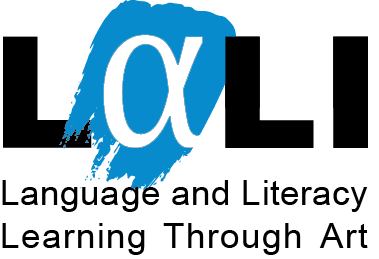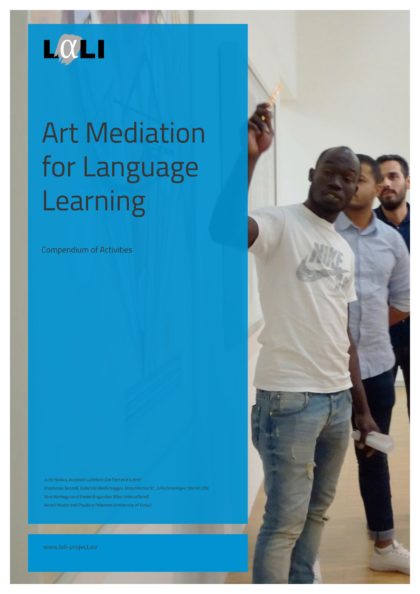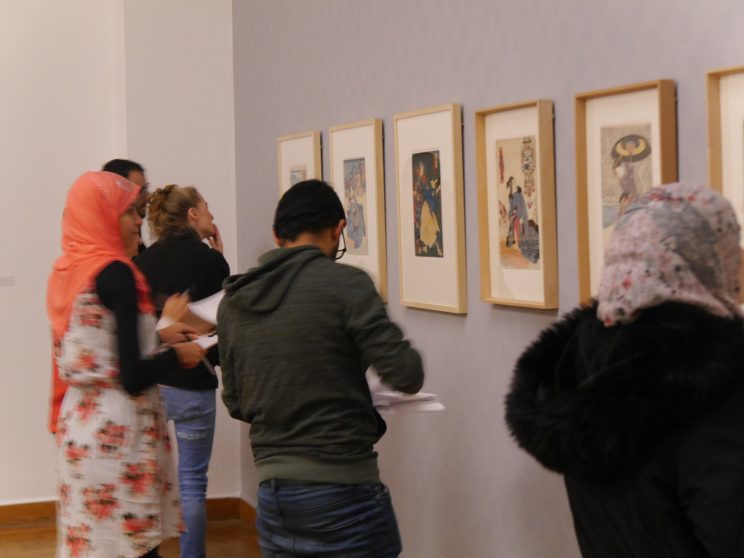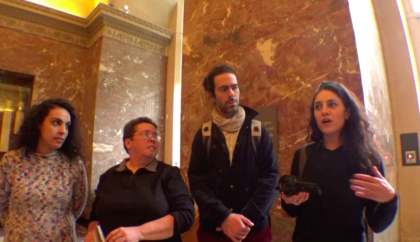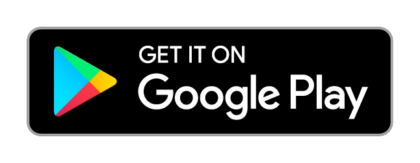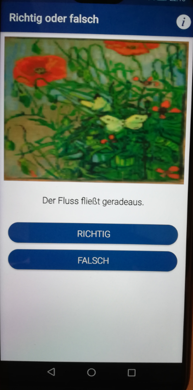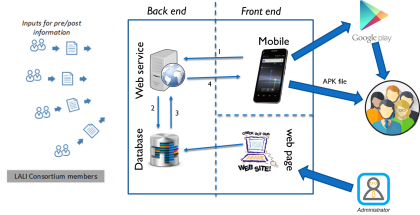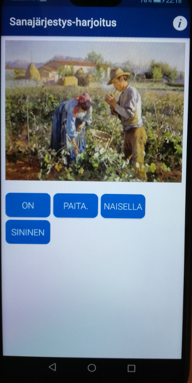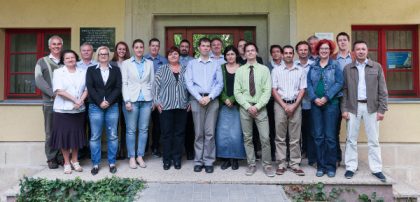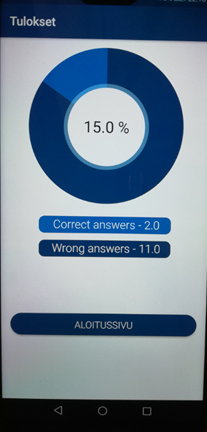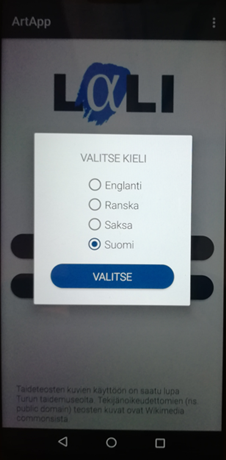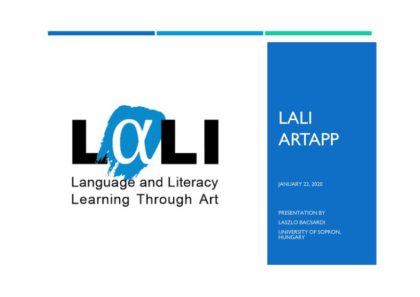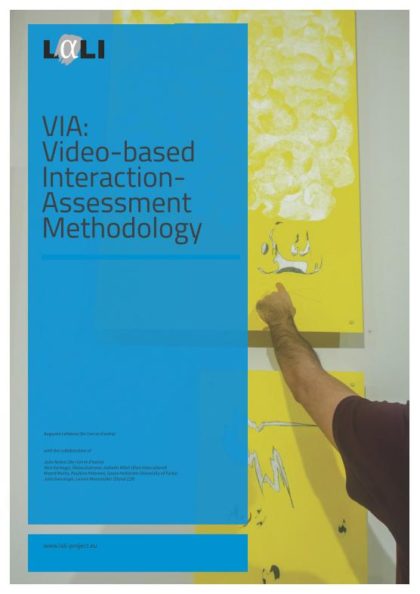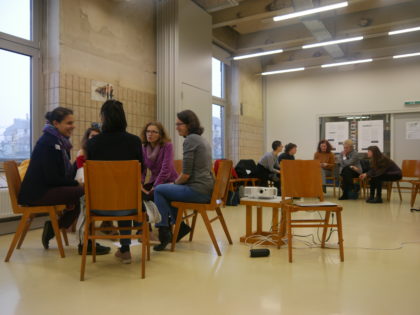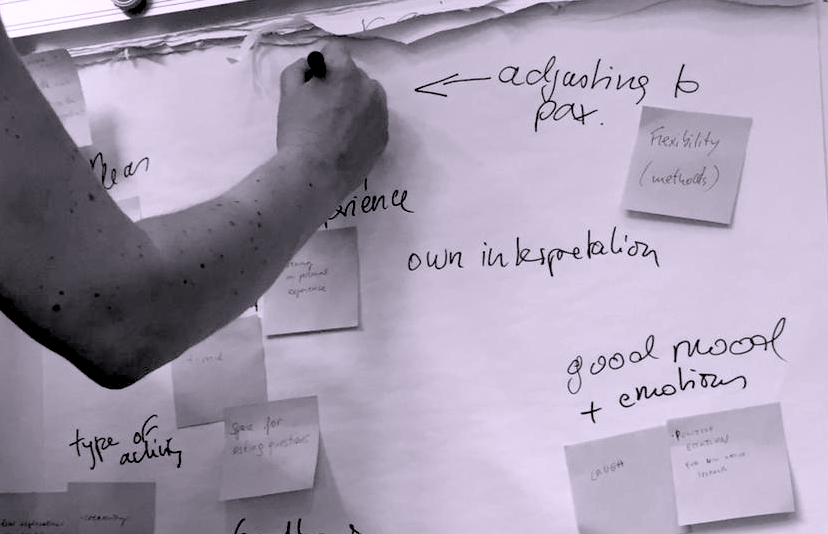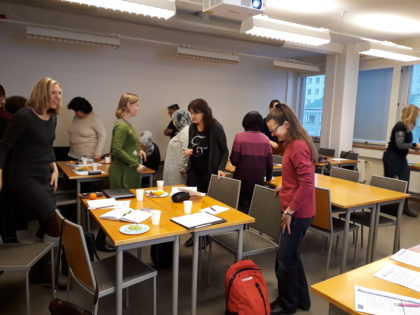The LALI Project
In post-industrial societies, employment and social inclusion depend crucially on the acquisition of basic and soft skills (e.g. home and/or local language literacy, intercultural communication and social abilities). Research shows that low-qualified and low-skilled adults are economically and socially marginalized: they occupy low-wage jobs while their low competence in literacy contributes to low self-esteem. Therefore, the development of new pedagogical tools aiming at promoting basic and soft skills among low-qualified adults and foreign language and culture among migrants is crucial both at the individual level (personal growth) and at the social level (fairer and more equal society).
The Language and literacy learning through art project (LALI) embeds language and literacy learning in cultural education by articulating activities in museums and activities in classrooms. An IT application “LALI ArtApp” was developed to support and reinforce the learning that takes place in museums. The quality of the whole process was assessed through a video-based tool. LALI evolved furthermore a toolkit to language teachers and trainers to improve their pedagogical skills. Lastly, LALI offers access to the different products and kits for professionals through this webpage.
LALI addresses the needs and social inclusion of adults with low qualifications and low literacy levels, mostly migrants, who have arrived recently or did not acquire the local language / literacy skills despite a long stay in their new environment. LALI contributes to the possibility of their further learning and employability by proposing pedagogical tools aiming at developing basic skills (language, literacy and to a minor degree digital skills), creating collaborative environments for learning, valorising their particular cultural identities, and using the encounter with art to address what is universally human.
Language and Literacy Learning Through Art
The Language and literacy learning through art (LALI) project embeds language and literacy learning in cultural education by articulating tasks in museums and classrooms. Thus, in addition to classrooms, learning is transferred into a real-world environment, specifically, to a museum that creates stimulating conditions for peer learning. Art (i.e., a central component of culture) therefore becomes a vital resource for fostering social and linguistic integration.
To get an idea of the theoretical and methodological considerations that provide the ground for this undertaking, please have a look at our manual.
This manual is part of the set of different products and kits for professionals that are available through an online resource centre created by LALI. All contents are considered creative commons. Please, feel free to browse through our webpage, get inspired and if you have questions, don’t hesitate to contact us!
Art Mediation for Language Learning
The LALI compendium offers a set of practical activities involving art works to lead in museums and classrooms to develop language, literacy and soft skills for adults with low qualifications.
The Compendium consists of 9 chapters. A preparatory chapter provide interactive exercises to get to know each-other, to introduce the art-based work or the museum setting. A closing chapter offers ways to assess and close the joint work. The seven core chapters revolve around specific thematic vocabularies: food and still life, people, leisure time, interiors and domestic life, nature, city and architecture, stories and myths. We open up each theme through art works from Paris, Vienna or Turku. But the art works we propose are not the only ones through which these vocabularies could be addressed. In fact the main message of our Compendium is that you can use these activities as blueprints to adapt them for the offer of any art museum you can find, and which is accessible for you with your groups.
Testing of LALI materials in Finland, Austria and France
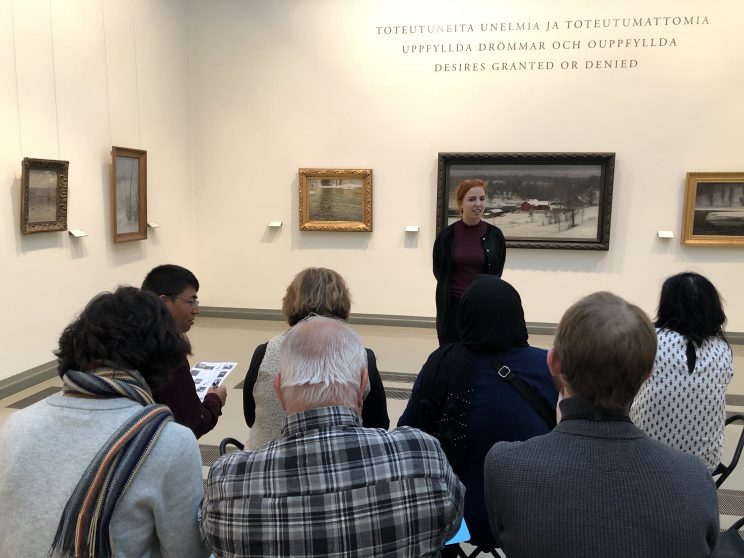 In Turku (FI), the first workshops following the LALI approach were organized during autumn 2018. Currently, we’re organizing the workshops for the second target group. The first group included participants with various backgrounds, including various countries of origin and first languages (such as Somali, Arabic, Persian, Albanian, and Thai). The youngest participants were in their 20s, some having stayed in Finland only a few months, while the oldest participants were in their 50s or 60s and had stayed in Finland for over thirty years. This heterogeneity is rather common for Finnish as a second language teaching groups for immigrants in Finland. The second group was relatively more homogenous, as the participants were stay-at-home mothers with young children. Yet also for the second group, the backgrounds of the participants were varied, including first languages such as Arabic, Persian, and Somali. In both groups, we have been happy to see how the participants engage in the LALI activities combining language learning and art mediation. The participants have enjoyed especially the interactive nature of the activities, the artistic activities, as well as visits to the Turku Art Museum. During the workshops, the participants have been able to develop their vocabulary knowledge as well as have been able to learn about both Finnish culture and each others’ cultural backgrounds through discussions prompted by the artworks.
In Turku (FI), the first workshops following the LALI approach were organized during autumn 2018. Currently, we’re organizing the workshops for the second target group. The first group included participants with various backgrounds, including various countries of origin and first languages (such as Somali, Arabic, Persian, Albanian, and Thai). The youngest participants were in their 20s, some having stayed in Finland only a few months, while the oldest participants were in their 50s or 60s and had stayed in Finland for over thirty years. This heterogeneity is rather common for Finnish as a second language teaching groups for immigrants in Finland. The second group was relatively more homogenous, as the participants were stay-at-home mothers with young children. Yet also for the second group, the backgrounds of the participants were varied, including first languages such as Arabic, Persian, and Somali. In both groups, we have been happy to see how the participants engage in the LALI activities combining language learning and art mediation. The participants have enjoyed especially the interactive nature of the activities, the artistic activities, as well as visits to the Turku Art Museum. During the workshops, the participants have been able to develop their vocabulary knowledge as well as have been able to learn about both Finnish culture and each others’ cultural backgrounds through discussions prompted by the artworks.
Feedback by Pilot course participants
Positive
• I learnt many new things and subjects
• the paintings help me to learn and understand and to remember the words better
• I liked the visits to the museums
• I liked looking at the paintings
• I liked making up stories
• I liked working in groups
• I liked drawing and artistic activities
• the teachers spoke clearly, they were good and young
• you got enough help if you didn’t understand
• it was good that we didn’t get any homework
• the atmosphere was cheerful
Negative / suggested improvements
• bad weather on the way to the museum / bad season
• the location of the museum on a hill
• more discussion
• more homework, because there was no homework
Reactions by facilitators of the pilot course
• Getting to know Finnish art history, contact with Finnish culture
• Language learning through pictures, artwork as educational material
• Taking into account cultural differences in teaching
• The studying environment (museum)
• Getting the chance to visit a museum, free admission for the participants
• Teaching in tandem (art and language experts)
The courses in Austria took place in two very different venues: Stand 129 – a market stall that functions as art & community hub in one of the most densely populated districts of Vienna, and Bank Austria Kunstforum – an exhibition space for modern and contemporary art in Vienna’s city centre that was currently showing an exhibition named “Fascination Japan”. For both target groups, the course was structured in weekly preparatory classes in a classroom setting at Stand 129 that focused on vocabulary and grammar and prepared for the weekly museum sessions in Kunstforum Wien. In the exhibition space, participants were often encouraged to explore for themselves, choose artworks of their liking and find the thematic connections in the broad collection of modernist paintings, precious Japanese prints and drawings. Participants appreciated working together and were most engaged when tasks had a clear connection to themselves or they could find parallels to their own background (e.g. through relating Japanese myths to Syrian myths). The course followed a thematic structure with topics that were discernible in the exhibition as well as pertinent for the participants’ applied language. Topics included “Eating and Drinking”, “Nature and Animals”, “City and Countryside”, as well as “Stories and Myths”, amongst other things. In both locations learning was attentive to already existing knowledge of the participants, co-learning was encouraged and multilingualism was appreciated. The topic of the exhibition encouraged further thinking about intercultural adaptations and valorisation of cultural diversity. In addition to improving their language skills, participants valued getting to know new people and learning about Japan.
Feedback by pilot course paticipants
“I also learned a little self-confidence that when I´m writing because I was afraid, I didn’t dare…but now it´s much, much better, I can write free sentences, although there are mistakes in there anyway but you just learn from your mistakes and you will slowly get better.” (Fatima)
“This course is good cause because you learn fast. I would like to do it again. The paintings and posters support the German learning process.
During the course I still had problems with understanding texts but I got familiar with so many words, even if I don’t understand every one of them, I got familiar.
And I remember things. The vocabularies became bigger.” (Farbarkary)
In France the two target groups showed fundamental differences. In the language learning workshops, we worked with foreign participants, either from North African countries or from Asian countries. The learners had various objectives when arriving in France; some followed their relatives already living in Europe and intended to settle there permanently, others only planned to spend a few years in France. In the literacy learning group, we met francophone participants who had not been able to benefit from a structured educational path for various reasons. The workshops aimed at experimenting with the resources developed within the framework of the LALI project. They were all structured in the same way: a preparatory class lesson systematically preceded the museum lessons in order to provide the learners with a proper vocabulary and grammatical structures for the visits which all took place at the Musée du Louvre. All activities favored interactivity, the active participation of participants, the enhancement of their experience and semi-autonomous learning. Foreign participants considered that learning stories and customs through French works of art was an important element for their social integration. Francophone learners, on the other hand, appreciated the access to cultural places that were unfamiliar to them.
Feeback by participants of the pilot course
“It’s true that it’s interesting because as I’m telling you it’s quite late that I come (to the Louvre / to the museum). When I see that and what we saw, it’s astonishing. (…) When we see it in real life as we said, it’s different. It’s astonishing, I congratulate you, it’s great! It’s emotional. (…) I would come back every day. (…) It’s funny to see their lives (in their time) and ours, we see that it is different. It’s history. It’s true that visiting … I have no word.” (Christine)
Feedback by facilitators of the pilot course
“The advantage of using works of art in literacy learning is that they serve more as mnemonic supports than a simple photo illustration because our learners are not used to engage with art works, which, in addition, allow a plurality of understandings and approaches.” (Pierre, facilitator and literacy teacher)
“I tested some activities that had been proposed during our training. The feedback is very positive! I had a heterogeneous group and this material allowed me to make all the learners active and to differentiate their objectives. In addition, they really appreciated being able to work on works of art and there followed a discussion about the museums and the outings to program.” (Aline, facilitator, language trainer)
LALI ArtApp
The LALI Art App is a mobile application developed to accompany the activities of the LALI compendium. It can be used for the preparation of visits as well as post-visit games helping to memorise / integrate elements of grammar or the seven thematic vocabularies. Please follow the instructions bellow on how to use it.
Download and links
The LALI ArtApp is available in Google Play Store. You can find it here:
User Manual for Android version
The LALI ArtApp will be soon available for also iOS.
About LALI ArtApp
The aim of the Language and Literacy Learning Through Art (LALI) project is to increase the language and literacy skills of the adults with low qualifications. In the modern technological environment, the learning process must be supported with modern devices. Nowadays, these devices are the smart phones. Therefore, a mobile application named ArtApp is implemented to help people to learn languages simply and easily.
After install the app, the user can select the language. The ArtApp is available in 4 different languages such as English, German, French and Finnish. After that, user can play a game and, in this case, a game means a quiz. A quiz includes 10 individual questions. There are two main kinds of quizzes: (1) Regular and (2) Mixed. The Regular means that the users can learn the language step-by-step mode. In a mixed game, user can get questions from all lessons. There are 11 different questions types in ArtApp, all of them have a different way to solve. There is an evaluation process after the quiz ends. Keeping questions up-to-date, a web application was implemented. New questions can be uploaded into the database through this web application.
From the point of technological view, ArtApp has a frontend and a backend. In the backend, MySQL database and web services in TomCat environment are running. There are two frontend implementations. One is Android which is done by now, the other is iOS environment which is under development phase. The ArtApp can be used from Android 5.0 (Lollipop). The web application was developed in Drupal environment.
The main architectural concept of ArtApp is the following:
Figure 1: Basic architecture of ArtApp
Here are some examples how the ArtApp works:
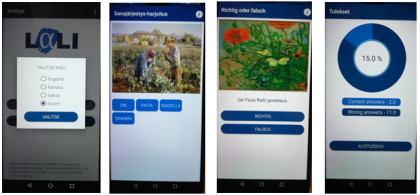 Figure 2: Art App Screenshots (from left to right: language selection, two examples of questions, evaluation)
Figure 2: Art App Screenshots (from left to right: language selection, two examples of questions, evaluation)
Presentation of LALI ArtApp
Thesises about the LALI ArtApp
Imre Erdei, Backend development for mobile application that supports learning foreign languages through artworks (BSc Thesis, 2018)
Supervisor: Dr. László Bacsárdi (University of Sopron)
Tamás Balogh, Get to know different mobile platforms and making mobile app on the selected platforms (MSc Thesis, 2019)
Supervisor: Dr. Gergely Bencsik (University of Sopron)
Artworks used in the Finnish version of the Art App
Lesson 1
Elin Danielson-Gambogi (1861–1919): Poutapäivä (1901) Turku Art Museum collection (Wikimedia commons)
Elin Danielson-Gambogi (1861–1919): Viinitarhassa (1898) Turku Art Museum collection (Wikimedia commons)
Gunnar Berndtson (1854–1895): Kesä (1893) Turku Art Museum collection (Photo: Vesa Kinnunen)
Lesson 2
Pekka Halonen (1865–1933): Iltatunnelma (1896) Turku Art Museum collection (Photo: Vesa Aaltonen)
Victor Westerholm (1860–1919): Kymijoen laaksosta (1901) Turku Art Museum collection
Lesson 3
Akseli Gallen-Kallela (1865–1931): Joukahaisen kosto (1897) Turku Art Museum collection (Photo: Kari Lehtinen)
Akseli Gallen-Kallela (1865–1931): Sammon puolustus (1896) Turku Art Museum collection
Lesson 4
Albert Edelfelt (1854–1905): Pariisin Luxembourgin puistossa (1887) Ateneum collection (Wikimedia commons)
Albert Edelfelt (1854–1905): Lopullinen luonnos teokseen Turun Akatemian vihkiäiset 1640 (1902) Turku Art Museum collection
Lesson 5
Juho Rissanen (1873–1950): Ruumiinpesijät (1908) Turku Art Museum collection (Photo: Kari Lehtinen)
Albert Edelfelt (1854–1905): Veräjällä (Portaan kylästä) (1889) Turku Art Museum collection
Eero Järnefelt (1863–1937): Raatajat rahanalaiset eli Kaski (1893) Ateneum collection (Wikimedia commons)
Lesson 6
Hugo Simberg (1873–1917): Perunatyttö (1901) Turku Art Museum collection
Albert Edelfelt (1854–1905): Louis Pasteurin muotokuva (1885) Musée d’Orsay collection (Wikimedia Commons)
Albert Edelfelt (1854–1905: Tohtori Emile Roux (1896) Turku Art Museum collection (Photo: Kari Lehtinen)
Lesson 7
Fanny Churberg (1845–1892): Asetelma (Pariisi) (1876) Turku Art Museum collection (Photo: Vesa Aaltonen)
Fanny Churberg (1845–1892): Asetelma (1877) Ateneum / National gallery collection (Wikimedia commons)
Wladimir Swertschkoff (1821–1888): Asetelma (Alger) (1885) Turku Art Museum collection
Lesson 8
Ali Munsterhjelm (1873–1944): Kalkkijaaloja Aurajoessa (1909) Turku Art Museum collection
Ali Munsterhjelm (1873–1944): Näkymä Aurajoelta (1930-luku) Taidesäätiö Merita collection (Wikimedia commons)
Marcus Collin (1882–1966): Sunnuntai satamassa (1914) Turku Art Museum collection
Lesson 10
Emil Wikström (1864–1942): Viattomuuden uni (1892) Turku Art Museum collection (Photo: Kari Lehtinen)
Georges Winter (1875–1954): Odotus (n. 1902) Turku Art Museum collection
Ville Vallgren (1855–1940): Ylpeys (1898) Turku Art Museum collection (Photo: Kari Lehtinen)
Lesson 11
Dora Wahlroos (1870–1947): Innoitus (Omakuva) (1895) Turku Art Museum collection (Photo: Vesa Kinnunen)
Helene Schjerfbeck (1862–1946): Omakuva (1915) Turku Art Museum collection
Elin Danielson-Gambogi (1861–1919): Elin Omakuva (n.1899) Turku Art Museum collection
Elin Danielson-Gambogi (1861–1919): Omakuva (1903) Turku Art Museum collection
Elin Danielson-Gambogi (1861–1919): Omakuva (1900) Ateneum collection (Wikimedia commons)
Dora Wahlroos (1870–1947): Omakuva (1943) Turku Art Museum collection
Axel Haartman (1877–1969): Omakuva maalaustelineen ääressä (1899) Turku Art Museum collection
Lesson 12
Akseli Gallen-Kallela (1865–1931): Poika ja varis (1884) Ateneum collection (Wikimedia commons)
Akseli Gallen-Kallela (1865–1931): Akka ja kissa (1885) Turku Art Museum collection
Evaluating the impacts of trainings in educational settings is a permanent preoccupation for researchers in education, as well as for professional facilitators and teachers. We addressed this preoccupation by proposing an empirical methodology based on video-recordings – the VIA methodology for Video-based Interactional Assessment Methodology. This approach allows the researchers/ professionals to develop a deep understanding of the social interactions that occur between the learners and the facilitators during their workshops and/or pedagogical activities. By working with VIA, we can identify the good, the problematic, the unexpected practices, and therefore to adjust continually the organization of the workshops in cultural mediation as well as in language learning activities, in classroom or in museums.
This manual contains two main parts:
1. Theoretical and methodological aspects of VIA method and how you could use it
2. Comparative analysis for the LALI pilot workshops’ assessment carried out in Paris, Turku, Vienna
Reactions by professionals (Paris)
“For the training, I brought a video without really knowing what information to draw from it, so we analyzed it together. I leave with the confirmation that the materials that I had intuitively offered allowed my interlocutor to develop a discourse that she would not have held otherwise. And then the discussion with the other participants made me realize that I could systematize this kind of practice in my field work.” (Tom, volunteer social worker, Paris)
“When you take a closer look at the videos recorded in class, you realize very important verbal and non-verbal details. Do we give the floor to learners? What relationship we establish with them? It’s very instructive to see yourself in action, in reality, with the learners. The discussion with others around the video is really interesting.” (Malika, volunteer language trainer in Paris)
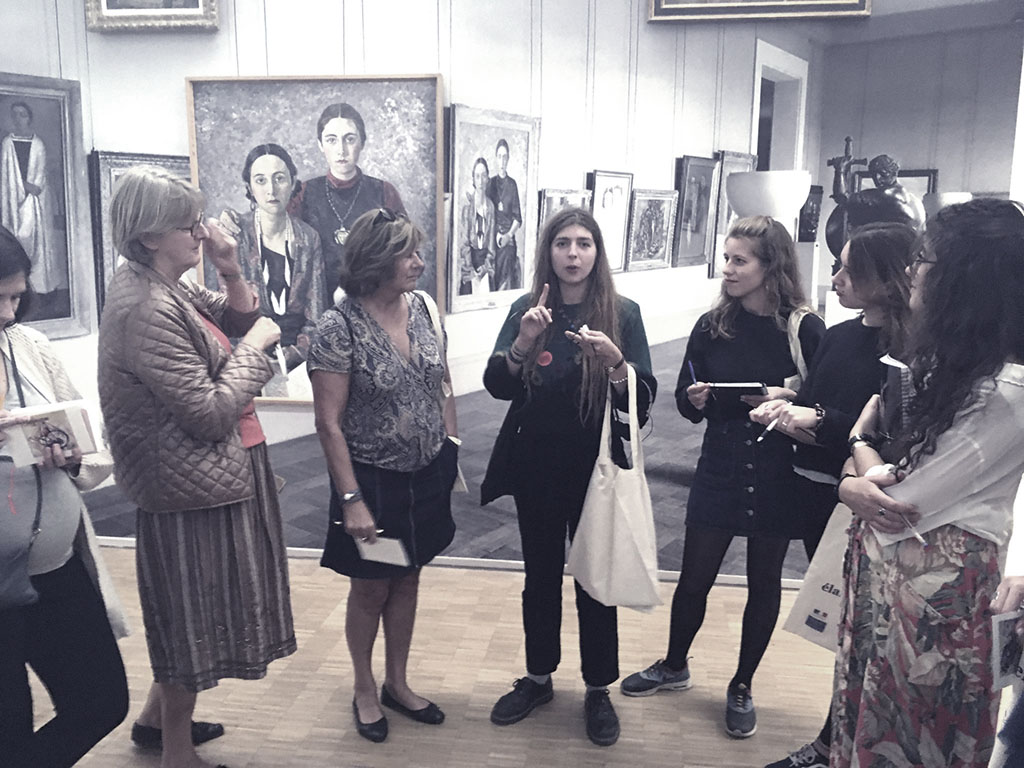
Download pdf LALI USER GUIDE
1. WHAT IS THIS TOOLKIT ABOUT?
The performance or success of language teachers as well as other trainers are mostly evaluated through the testing of their learners (to assess what has been learnt) or through satisfaction surveys inquiring about how happy the students are with the learning experience. And though such feedback is invaluable, it does leave some important blanks. Indeed, nor the performance of learners, nor their satisfaction rates can give a proper and precise account on the particular strengths and weaknesses of the trainer’s posture and methodological habits, so she can celebrate and valorise what she is good at, and further develop other aspects of her practice.
It is for this purpose that we propose our toolkit. It can serve language teachers and trainers, but also other educators involved with heterogeneous groups of adult learners. This toolkit will help to identify defining moments of a training process (rather than elements of content) and invite teachers, trainers to reflect on their practices. Read More...
How to use the toolkit?
This toolkit can be used in two ways: it can be integrated into training processes where it is used collectively, but it can also be used as a self-learning tool for teachers / educators who wish to use it independently. In both contexts the toolkit is based on the same five steps, which we are presenting bellow. Wherever relevant, we indicate variants of how to use the toolkit according to group training / self-learning context.
For the sake of simplicity and easy reading: from now on we’ll use the word “facilitator” and “trainer” as synonyms, to refer to a wider range of educators, language teachers involved with adults in different types of educational activities focusing on developing language and writing skills. Furthermore, because of the high dominance of women in these professions, we opted for using the feminine instead of masculine, we’ll make less errors this way statistically.
2. GETTING ACQUAINTED WITH OUR MAP OF CONCEPTS
The next step consists in getting acquainted with some concepts and models about the success of learning experiences. Understanding these concepts will be important before trying to answer the questionnaires, simply because there may be some new concepts, or some technical terms which we may use in slightly different way than other authors.
Read More...IN TRAININGS
For a bottom-up approach in training settings, we recommend an interactive exploration of the “active ingredients”. For instance, you can carry out a brainstorming activity together on the “specificities of adult learners” and the « success factors » of adult trainings. This could be done through an adaptation of the “Hello game” of Thiagi [x].
Make three small groups and give one of the questions to each group:
- What are the distinguishing features of adult learners as opposed to children?
- What are the success factors of adult training processes?
- What are your most cherished competences as adult trainers?
Give 15 minutes to small-group work and then 5 minutes to each to present what they found. New items can be added during the plenary discussion.
[x] For the basic description of the activity please see: http://thiagi.net/archive/www/game-hello.html
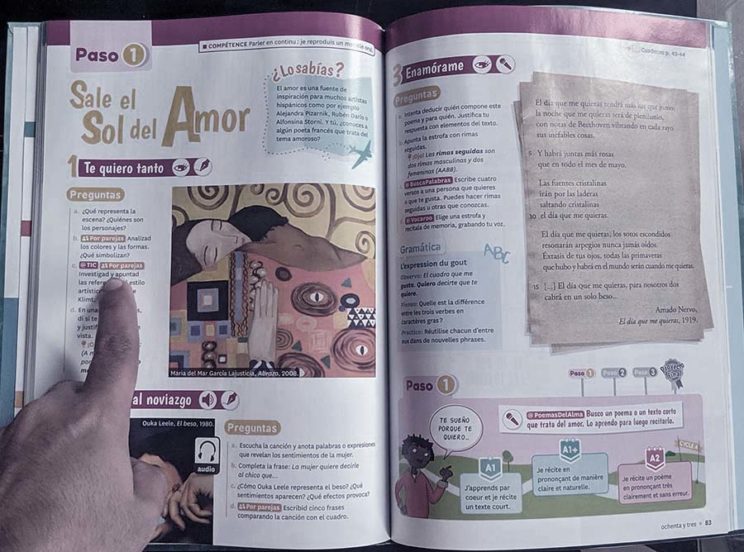
Download PDF: LALI questionaire plan and programme
3. PLAN AND PROGRAMME
The attitude of rigidity is frequent in the beginner’s work and often associated with a rigidity of the pedagogical approach of the facilitator who sticks strictly to his sheet of preparation of activity. It is a way of reassuring oneself, of limiting risk taking in communication with learners, which the beginner is afraid of not being able to manage. This way of being and this way of doing block any opening and any communication with the students. By sticking to a rigid preparation, the facilitator is deaf and blind in front of his class, the course could take place without students (Moulin, 2004).
Download pdf LALI quality of presence // LALI questionaire quality of presence
4. QUALITY OF PRESENCE
The voice, the body, the presence of the educator are her main tools, everything she does is mediated through her presence. The word presence inevitably evokes a double perspective: internal and external, presence perceived and seen. We have an internal sensation about our body, and at the same time it makes a visual impression on others. The same is true for our voice, our emotional landscapes and our self-presentation strategies. Our video-based method will help bridge this apparent gap between the internal and the external, helping you to be able to use the inner sensations as feedback in a more mindful way, with a little bit of more awareness.
Download pdf LALI Relation to the participants // LALI questionaire relational
5. RELATION TO THE PARTICIPANTS: HORIZONTALITY, VERTICALITY
How do we relate to participants, what type of connections are there.
What is this dimension about?
One of the key features of a learning experience is the hierarchical distance between learners and teachers. In a vertical setting the roles are very asymmetrical: the teacher is seen as the one possessing the relevant knowledge, responsible for passing it to the learners, who are passive receptors. In a horizontal setting the contributions of participants are valorised, their experiences considered important.
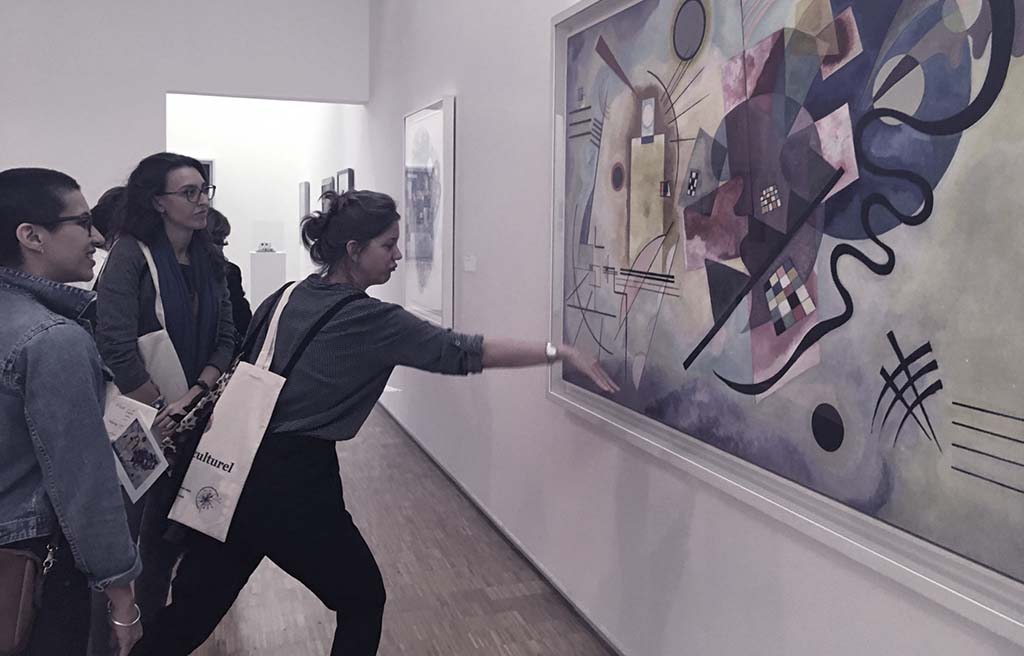
Paris, Centre Pompidou
Participants were requested to introduce themselves through art works displayed in this room. They were invited to identify art works that reminded them of their origins, that they could connect to their profession and that they connect to their future. Once the artworks are identified each participant explains why they chose that particular artwork
Download pdf LALI Pedagogical landscape // LALI questionaire pedagoical landscape
6. PEDAGOGICAL LANDSCAPE
What is the nature / texture of the learning process and the proposed activities?
Short intro what is this
It may be heard to find anyone who would oppose the idea of using a “diversified” set of methods and activities. But what does this “diversification” actually mean? In what way can methods and activities fundamentally differ? The selection bellow offers an overview of different approaches, mainly based on recent developments from the field of educational neuroscience. The fact that these approaches are backed up by recent findings of neuropsychology does not mean that some of these techniques have not been applied for centuries, rather that new evidence still supports the benefits they may bring about. As before, it is not our objective to impose on you these approaches. Whether a trainer wishes to use one or another approach should depend on the context of her work, her own predisposition etc. Instead, we continue to offer you a mirror to explore your preferences, norms and how they become reality in your interventions.
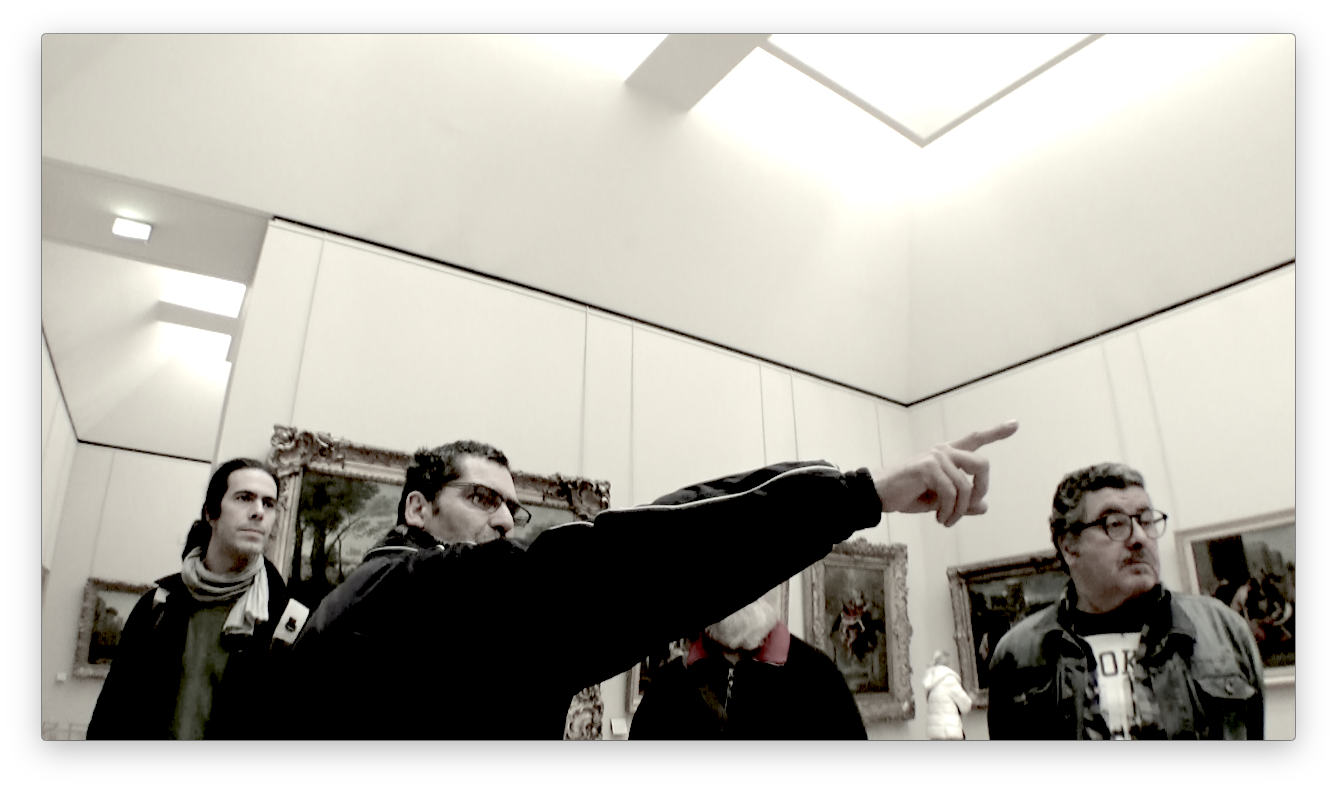
Extract Paris Louvre, de l’art et d’autre: The participant was asked to find an interesting architectural element on one of the paintings in the room. He guides the whole group, including the facilitators, to show them and explains his choice.
- The participant selects specific graphic elements.
- He produces corresponding descriptive elements.
- He appropriates the other artworks in the room in order to explain his choice.
Download pdf LALI the place and use of art // LALI questionaire place of art
7. THE PLACE AND USE OF ART
What is the use of art in the learning process, what does it serve?
Short presentation
You may or may not be already using artworks in your classes, depending on your current practice this section can be of use to you like the other sections as a mirror of your activities or mainly as a source of inspiration on how you could integrate art works as a pedagogical resource. In the LALI project our aim was to test how the integration of art works could enrich the teaching of local language and literacy to migrants or low language skill adult learners, and we discovered that art can be beneficial for at least six different perspectives, that we’re going to share with you bellow.
Reactions by professionals (Turku)
– very well made and interesting
– useful for the development of teachers’ own reflection
– the statements are very context bound and therefore difficult to use at times
– helped to see the course of action
Individual commitments that were developped at a workshop by professionals (Vienna)
“I will ask open questions and open myself to many possible answers and new questions from participants” (language trainer, Vienna)
“I will leave more space for the participants when they learn and work on exercises.” (language trainer, Vienna)
” I will use art work to sharing with participants aspects on their own culture.” (language trainer, Vienna)
